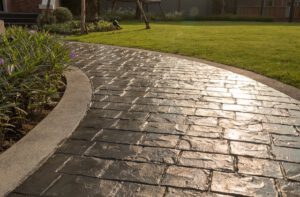Polished concrete is a popular flooring choice in commercial spaces for its sleek, modern look and durability to withstand heavy traffic and cleaning. However, getting polished concrete floors right requires careful planning and precision from the beginning—including choosing the right mix design, placement, finishing, and curing.

Variables such as existing slab quality, miscellaneous contaminates, patterns from previous floor coverings, stains, nail holes, patched areas, and flatness can significantly impact finish results. Contact Polished Concrete Orange County for professional help.
Polished concrete has become a popular choice for modern flooring due to its durability and unique aesthetic. This durable material is known for being an excellent flooring option for high-traffic areas, and its versatile look can be customized with different stain colors, patterns, and gloss levels to suit any design aesthetic.
While polished concrete has long been a staple in commercial and industrial environments, it is now also becoming more common in residential spaces as well. Polished concrete’s sleek, contemporary appearance is a perfect fit for any modern or minimalist design, and its reflective surface can open up space and create a sense of brightness.
In addition, polished concrete can be stained or dyed to achieve a wide variety of color options. The level of shine can be adjusted as well, from matte to satin to high-gloss. The aggregate exposure can be altered as well, allowing for minimal exposure to create a sleek look or more pronounced aggregate for a rustic feel.
Additionally, polished concrete can be imprinted with any type of pattern or logo to further enhance the aesthetics and add a sense of personalization to any space. This can be especially beneficial in corporate offices or other public spaces where a brand identity is important.
Because polished concrete is a sustainable option that utilizes the existing slab, it is an environmentally friendly solution as well. It is also hypoallergenic and resistant to mold growth, making it a great choice for spaces where people may suffer from allergies or sensitivities.
Unlike other types of flooring, such as carpet or tile, which can harbor mold, bacteria, and dust mites, concrete is an anti-microbial material. This can help reduce the risk of health issues in sensitive spaces, such as hospitals and schools.
In addition, polished concrete is easy to clean and maintain. Regular sweeping and vacuuming can remove dirt and debris before it has the chance to scratch or damage the surface. Mopping with a pH-neutral cleaner can further help keep the floor looking its best. In addition, it is a good idea to dry the floor thoroughly after mopping to prevent water spots and potential damage.
Durability
Polished concrete is a simple, traditional building product that’s become an increasingly popular flooring option for modern residential and commercial spaces. This trend is due to its versatility, affordability, durability and hygienic qualities. It’s also extremely customizable, allowing homeowners, business owners and architects to create floor designs that fit their vision for the space.
The process of polishing concrete begins with the removal of any existing coatings, adhesives and sealants to expose the bare concrete surface. Next, the concrete is ground using diamond-tipped blades over a series of grit levels to produce a smooth and consistent finish. Typically, each step in the grinding process is followed by a water rinse to remove any residual grit and prepare the surface for the application of an impregnating enhancing concrete sealer.
This is a non-chemical, non-yellowing product that will provide an excellent level of protection and shine for your polished concrete floor. It will not chip, flake or peel and is available in 24 stock colors that represent the most common color choices seen in floors today.
The high light reflectivity of polished concrete makes it a great choice for spaces that need to project a clean, professional image. It’s ideal for offices, warehouses, restaurants and retail stores, as well as any other space that needs to be both functional and attractive.
Because of their durability, polished concrete surfaces can withstand heavy traffic and are ideal for areas where forklifts will be operating. This is because a polished concrete surface can withstand the impact of forklift tires and will not wear down as quickly as other flooring materials such as vinyl or tile.
Although a concrete floor is very durable, it is not immune to damage or stains. Stains from grease, oils, soft drinks and solvents can seep into the surface and cause permanent damage if not cleaned immediately. It is important to maintain a proper maintenance program that includes regular sweeping and mopping with a neutral pH cleaner.
Moisture can damage the surface of a concrete floor, causing it to expand and crack during freeze-thaw cycles or promote the growth of mold in humid environments. It is important to install a moisture barrier on any concrete surface that will be exposed to the elements to protect it from water infiltration.
Low Maintenance
Concrete is commonly thought of for garages and basements but it is also a practical flooring choice for kitchens, living rooms, and even offices. Polished concrete is durable, aesthetically pleasing, and requires very little maintenance to keep it looking immaculate.
While the process of turning a plain slab into a polished masterpiece is highly technical and requires real craftsmanship, it is also an incredibly cost-effective option for businesses seeking both functionality and value. Once the initial coarse grinding is completed and any cracks or blemishes are repaired, the surface can be grinded with a series of progressively finer diamond grits to achieve your desired level of sheen. A final coat of densifier and sealer is often applied to strengthen the surface, improve its resistance to moisture and stains, and enhance its shine.
In addition, the low porosity of polished concrete reduces dust accumulation and simplifies the cleaning process. The resulting streamlined maintenance routine saves businesses time and money while eliminating the need for harsh chemicals, contributing to a healthier indoor environment. These cost savings align with the growing movement toward sustainable hygiene practices and further reinforce the appeal of polished concrete as a practical and environmentally responsible choice for commercial spaces.
Unlike other flooring materials, such as carpet or tile, polished concrete is virtually impermeable and does not easily harbor dirt, grime, and harmful bacteria. These attributes contribute significantly to the longevity of polished concrete floors, minimizing their need for replacement and lowering overall maintenance costs. However, a floor should be kept dry to minimize the risk of corrosion and potential damage to the concrete itself. As such, it is recommended that regular dust mopping or mopping with water and a mild, neutral-pH cleaner be performed.
Versatility
Concrete is commonly associated with basements, garages and patios, but this versatile material can also be used in many commercial and residential spaces. When polished, concrete becomes a sleek and elegant surface that complements numerous design aesthetics. This material is a popular choice for modern retail spaces, showrooms and hotels, as well as contemporary home interiors.
The concrete polishing process involves grinding and honing the concrete surface with bonded abrasives to achieve its desired sheen and smoothness. It can be performed on new or existing concrete, and it can be done while the space remains in use. The surface of polished concrete is incredibly durable, making it an excellent choice for high traffic areas. It is resistant to fluids, and it can be sealed with a concrete protectant that prevents staining from oils and chemicals.
With a variety of finishes and colors available, polished concrete can be customized to fit any design aesthetic. The smooth, glossy finish enhances natural and artificial lighting, creating a bright, open atmosphere. Alternatively, it can be finished with a matte or satin coating to hide dirt and wear, and create a more subtle look.
When using polished concrete in a restaurant, office, or other commercial space, it is important to select a contractor that understands the specific needs of the project. For example, some owners may want a level of aggregate exposure that shows off the raw materials in the concrete, while others prefer a completely smooth, shiny floor. A professional concrete grinding and polishing company will be able to provide the options that best suit the space.
In addition to offering a beautiful, stylish look, polished concrete provides health and safety benefits. Its dense, non-porous surface repels dust and allergens, promoting a cleaner and more breathable indoor environment. It is also easy to clean and maintain, making it an ideal choice for kitchens and other busy living areas.
The versatility of polished concrete makes it a popular flooring option in both commercial and residential settings. Its durability, low maintenance requirements, and aesthetic flexibility make it a perfect choice for retail outlets, restaurants, offices, warehouses, car dealerships, hospitals, and other large facilities. It is an especially good choice for high visibility areas that need to be both functional and attractive, such as lobbies, elevator shafts, corridors, and restrooms.
